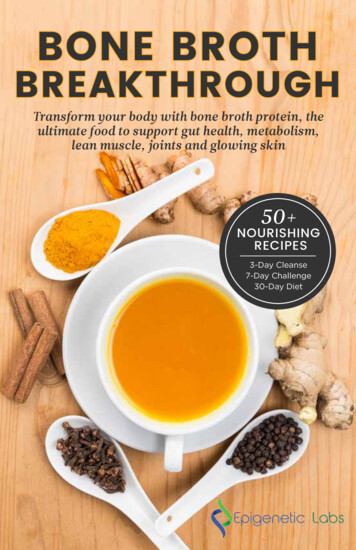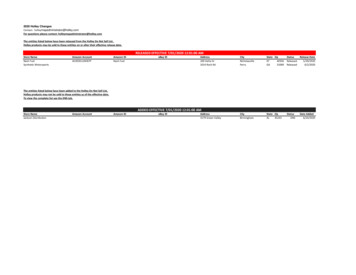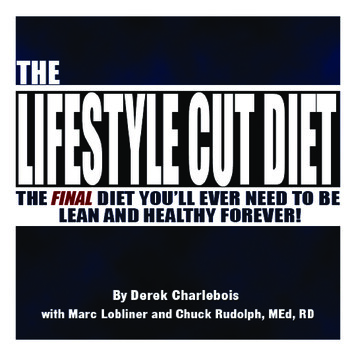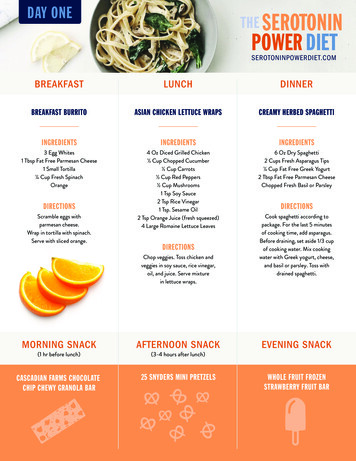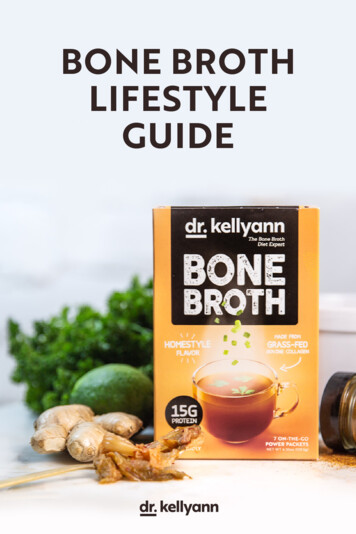
Transcription
BONE BROTHLIFESTYLEGUIDE1.
2.
A Note From Dr. KellyannAs a naturopathic doctor, I have made it my mission since day1 to inspire my patients to transform into a healthier, happierversion of themselves.Bone broth has always been the cornerstone of my weight lossand healthy lifestyle plans (I don’t call it liquid gold for nothing!)and with this Bone Broth Kit, you’re getting all the benefits ofthis ancient superfood without all the work.If you are joining this program for the first time or simplyrevisiting it, I am so excited for you to experience the incrediblebenefits of adding two cups of bone broth to each day!3.
BENEFITS OF BONE BROTHI’ll be clear, bone broth is not your typical, everyday dietplan. Understanding why your body relies on certain foodsand should avoid others is vital to your health and longevity and learning to take control of your health doesn’t have to bedifficult! In fact, I’m here to show you an easier way. But first,it’s important to know why I use bone broth in all my plans.Bone broth is rich in glycine and glutamine, two vital aminoacids that support your health in a multitude of ways. It alsocontains chondroitin sulfate, glucosamine, and supportsintermittent fasting as a weight-loss tool.Bone broth can help: Diminish fine lines and wrinkles Plump skin and reduce the appearance of cellulite Even skin tone and give you a healthy glow Brighten dark spots and under-eye circles Support healthy nails and hair Promote comfort and improve joint function Improve sleep, mood, and energy levels Soothe your stomach and support a healthy gut Curb craving and support healthy weight loss4.
Bone Broth Diet for Healthy Weight LossBone broth has always been the cornerstone of my weight lossand healthy lifestyle plans because it’s very filling, loaded withnutrients and protein, and very low in calories. Bone broth isalso great for curbing sugar cravings! And thanks to the proteinit helps you stay fuller longer, meaning that even if you do geta craving for those sugary drinks and snacks, you can rely onbone broth to fill you up, without adding pounds!Additionally, bone broth can support intermittent fasting.Intermittent fasting, or IF, is simply going for a certain periodof time without food, typically 12, 16, or even 24 hours. IF isa great weight loss tool but it’s not always easy for beginners.Bone broth bridges this gap by providing nutrients andsatiation, while being low calorie and low-carb, meaning itwon’t hinder the weight loss benefits of IF and it can evenhelp extend your fasting window.5.
The Basics of the Bone Broth LifestyleBone broth & collagenSo what’s the big deal about collagen, anyway?Collagen is a protein naturally produced by your bodyand is responsible for your skin’s elasticity. And whileit’s our most abundant protein, natural production,unfortunately, begins to slow with age.But there’s good news! Collagen can be restored byconsuming those tough-to-eat portions of animals,such as the bones and ligaments, which is where bonebroth comes in. When you prepare bone broth, you’llend up with an easily digestible, nutrient-rich gelatinthat is formed by the collagen being cooked out of thebones and ligaments. Or, you can source this fromhydrolyzed collagen, which is featured in my powderedbone broth. Gelatin and hydrolyzed collagen do havesimilarities, but differences worth noting.Fast Fact!Both hydrolyzed collagen and gelatin are made fromanimal collagen and share the same amino acidprofile. But their properties and structure are a littledifferent, in that hydrolyzed collagen can break downinto much smaller units of protein.This process makes it more easily digestible, anddissolvable in both cold and hot water. On the otherhand, gelatin is unable to dissolve in cold water butcan still be a great source of essential collagenbuilding amino acids.6.
The Basics of the Bone Broth LifestyleIntermittent fastingIntermittent fasting has been around longer than you maythink. That’s right, our early ancestors who were huntersand gatherers would sometimes go days without eatinga substantial meal. The feast-or-famine lifestyle wasnormal then, and the human body adapted accordingly.Believe it or not, these periods without food gave theirbodies time to heal, cleanse, and rejuvenate. IF was theirnatural healing process, and it can be for us too, thoughwe’re lucky to have several ways to “fast” without daysof deprivation.When it comes to IF I recommend two options: a dailyfasting window of 16 hours, or a longer fast of 24 to 36hours just twice a week. The benefits of going mostlyfood-free for these short periods of time can reallymaximize results when committing to a lifestyle ofhealthy fats, lean proteins, veggies, and some fruit,and being conscious of processed food intake.7.
The Basics of the Bone Broth LifestylePaleo foodsWhat I love about the Paleo way of eating is that it focuses onwhole, nutrient-dense foods and eliminates processed foods.Paleo is a way of life that takes you back to nature and thesimple foods that are easily absorbed, digested, and genuinelybeneficial to your body, including:VegetablesFruitsLean MeatsSeafoodHealthy FatsWe can live much healthier lives and face fewer modernday diseases when we avoid eating these foods as muchas possible: Grains Legumes (this includes peanuts) Dairy Refined sugars (this includes sugary drinks) Processed foods Refined vegetable oilsBy cutting out the processed foods, sugars, and starcheswe are so accustomed to, we jumpstart our weight lossand maximize our health.8.
The Basics of the Bone Broth LifestyleLow carb & low sugarEating a diet low in sugar and carbohydrates goes hand-in-hand. High-glycemic foods, like processed foods andhigh-starch vegetables, can raise your blood sugar just asmuch as white sugar can.For example, your body doesn’t know the differencebetween a supermarket green drink and a can of cola,or between mashed potatoes and those organic sweetpotato chips. All your body knows is that it has to dealwith processing the massive sugar hit, meaning it can’tfocus on processing the stored sugar (i.e. fat), that yourbody has already accumulated.If you’re experiencing the same frustration, know this:When you ditch the sugary, high-carb foods that causeblood sugar swings, stored fat, and gut damage, you willeventually begin to lose weight naturally. You just need togive your body time to flip its fat-burning switch to “on!’’If you want to lose weight and live a healthy, sustainablelifestyle, low-sugar and low-carb are the way to go. Aftermore than two decades as a weight-loss transformationexpert, I can tell you that this is the most effective way totake off pounds.9.
YES FOODSProteinCollagenProtein PowderBeefChickenLambTurkeyWild boarFishEggsOrgan meatsDeli meats(make surethey are freeof nitratesand uitGrapesPortions:Non-Starchy Veggies: should be at least the size ofa softball. Fill your plate with 2-3 softballs' worth.Protein: should be about the size and thicknessof your palm. Starchy Veggies: ½ cup per meal.Fruit: about ½ cup, twice per day.10.
Non-Starchy VeggiesArugulaAsparagusBell peppersBok choyBroccoliBroccoli rabeBrussels sproutsCauliflowerCeleryChili peppersCilantroCucumbersDaikonEggplantGarlicGreen beansGreen cabbageGreen onionsGreens(beet, collard,mustard, andturnip greens)Jalapeño peppersKaleLeeksLettuceMushroomsNapa cabbageOnionsParsleyRadicchioRadishesRed cabbageSeaweedSpinachSproutsSummer squashSwiss chardTomatoWatercressZucchiniStarchy VeggiesPotatoesSweet potatoesYamsPumpkinCarrotsButternut squashSpaghetti squashBeetsTurnipsPlantainsParsnipsGreen peasHealthy FatsCoconut oilOlive oilAvocado oilGheeCoconut chipsAvocado (¼-½)OlivesUnsweetenedalmond milk(carrageenan-free)Almond butterNutsChia seedsHemp seedsGround flaxseed11.
NO FOODSAdded sugars (includingsugar alcohols andartificial sugars)Frozen pizzaAgave syrupGlutenAlcohol (in any form)Grains and pseudo-grains,or grain-like products(amaranth, buckwheatand quinoa)Bacon (that containsnitrates and/orsweeteners)BeansButterCheeseCorn and CornstarchDairy (any productcontaining)Frozen yogurtGranolaHoneyIce creamJam and JellyJuice (fruit and vegetable)LegumesDeli meats (thatcontain nitrates)LentilsFrozen fruit bars (thatcontain sweeteners)MargarineFrozen mealsFrozen meats (thatcontain nitrates)12.Maple syrupMilkOatmealPasta
PopsiclesSodaProcessed foods (all)SoyRiceSugar (white and brown)Salad dressingTofu and vegetarian “meats”Salt (table)Vegetable oils (canola, corn,peanut, safflower, etc.)Sauces and condiments(commercial)Sausage (thatcontains nitrates)Yogurt (dairy-based and/or high-sugar versions)13.
Macro GuidelinesMacronutrients are the carbohydrates, proteins, and fats inour diet. While each one of us is unique and our macronutrientrequirements depend on our age, metabolism, and activitylevel, following the general guidelines will keep you feelingyoung and healthy.If you’re not doing intensive workouts or other strenuousactivities, start out very low-carb and focus on protein,non-starchy vegetables, and healthy fats. If you’re doing a lotof heavy-duty exercises every day, start out at a higher rangeand see if you need to work your way down.An important part of living a healthy lifestyle is learning tolisten to your body and its hunger cues. So if you find yourselffeeling too full, or still hungry after meals, alter each categoryuntil you find the right fit for your goalsand activity level.CARB CONTROLLose weight:50 to 75 net carbs(go lower as needed)Maintain weight:75 to 150 net carbs14.Gain weight:150 to 200 net carbs
Not all types of carbs affect you the same way, so whenyou are counting carbs you want to focus on net carbs.Starches and sugars get absorbed rapidly and are convertedto glucose, causing your blood sugar and insulin levels tospike. This packs on the pounds. Fiber and sugar alcoholslike erythritol, however, are absorbed slowly (or not at all)and metabolized differently. As a result, they don’t causeyour blood sugar and insulin levels to rise.Total Carbs - Dietary Fiber - Sugar Alcohols Net CarbsAdequate proteinProtein recommendations are often way too low for dailymaintenance, so I recommend:90 to 120 grams of protein per day for women120 to 180 grams of protein per day for menHealthy fatsHealthy fats are fats that occur naturally or with minimalprocessing such as avocado, coconut, butter, and otheranimal fats. It’s best to stick to naturally occurring fats, andavoid foods that contain soy, seed oils, dairy (unless you knowdairy doesn’t negatively affect you, then minimal amounts ofgrass-fed butter should be fine). While I don’t generally givea hard and fast rule for healthy fats, try and stick to no morethan two servings per meal. This is because I’d rather you eathealthy fats when needed than those high-sugar andhigh-starch carbohydrates.15.
Perfect Meal PortionsPROTEINVEGGIESFATFRUIT1-2 Servings ProteinA serving should be about the sizeand thickness of your palm.1-2 Servings FatA serving of oil, clarified butter, nuts,avocado, or other approved fats is about thesize of your thumb or 1-2 tablespoons.1 Serving VeggiesStarchy Veggies: The size of your closed fist.Non-Starchy Veggies: Unlimited1 Serving FruitA closed fistful or half an individual fruit.16.
Intermittent FastingOptionsDaily 16-hour fasts (16:8)Condense your meals into an 8-hour window (fasting for16 hours) and replace breakfast with 1 to 2 cups of bonebroth. For lunch and dinner, follow my portion guidelinesfor creating a Perfect Meal (be sure to stick to only“Yes” foods!). I recommend only consuming your fruitportion once a day during the meal of your choosing andskipping starchy vegetables if you are mostly sedentary.Bonus: if you consume just one cup of bone broth beforeyour meals, you can enjoy your second cup of bone brothany other time during the day!Twice weekly fasts of 24-36 hours (5:2)Five days a week, follow my portion guidelines forcreating a Perfect Meal and stick to only the “Yes”foods. Again, I recommend only consuming your fruitportion once a day at the meal of your choosing andskipping starchy vegetables if you are mostly sedentary.Two days a week, fast for 24 to 36 hours, consumingonly water, and up to 4 cups of bone broth during thefasting period.17.
How To Use Bone BrothMaking your powdered bone broth couldn’t be more simple!Grab your favorite mug, pour in the contents of one packet,and add 8-12 ounces of hot water. A small whisk or handheldfrother can be helpful here.You know this bone broth can be sipped, but it can also beused in any recipe that calls for bone broth. For every cup ofbone broth needed, simply dissolve one packet of powderedbone broth in 8 ounces of hot water. Trust me, your bonebroth never needs to be boring and I love trying new flavorcombinations all the time!18.
When I want to jazz up my bone broth but still keep it simpleI add a dash or two of some of the following: Salt White or black pepper Garlic powder Onion powder Lemon juice Hot sauce Worcestershire sauce Apple cider vinegar Truffle oil Smoked salt Coconut aminosWhen I want something mild but bursting with flavor I’ll gowith one of these combinations: Salt, pepper, chives,and lemon juice Garlic and onion powder,salt, and smoked paprika Ginger, garlic powder,and lemon juice Garlic powder, ginger,cilantro, coconut aminos,and lime juice Truffle salt and gingerWhen I really want to spice it up go for one of the following: Hot sauce (or cayennepepper) and lemon juice Hot sauce, or Sriracha, limejuice, salt, garlic powderand coriander (or cilantro) Chili powder, cumin,cayenne pepper, garlicpowder, onion powder,and paprika Turmeric, garlic powder,and black pepperFor even more ideas on how to use your bone broth in a meal,check out some of my amazing recipes on drkellyann.com!19.
Additional Ways ToUse Bone BrothBone broth is nutrient-rich and makes a healthy addition toyour daily routine whether it’s sipping on it to curb cravings orto replace sugary snacks. And luckily there are so many moreways to use bone broth, such as in:Soups and stewsRice or gravyMarinadeSautéesCocktailsPopsicles20.
Additional Ways ToUse CollagenOnce you’ve gotten yourself into your daily bone broth habitand notice the amazing health and beauty benefits, you’llnever want to miss a daily dose of bone broth again!But did you know? It’s the collagen-rich gelatin in bonebroth that works all the magic. You see, collagen comes fromthose tough to eat portions of animals, such as the bones andligaments. When you prepare bone broth, you’ll end up withnutrient-rich gelatin. Gelatin is basically cooked collagen.Bone broth and hydrolyzed collagen are both made fromanimal collagen and share the same amino acid profile andthis creates several ways to get in a daily dose of collagenand never be bored.Here are my favorite ways to incorporate bone broth andcollagen into my lifestyle: A cup of bone brothSoups and stewsCollagen coffee or matcha*Smoothie or smoothie bowlBaked goods*Sauces and Dips*Add a few scoops of my flavorlessmy Complete Collagen Protein21.
How To Make The PerfectCollagen Smoothie22.Check out my fun and delicious smoothiesrecipes at drkellyann.com.
Cleansing FoodsBone broth and collagen truly are powerfoods when youlook at all their health benefits. And I believe the morebeneficial superfoods you can pack into your lifestyle, thehealthier you will be! So, in addition to bone broth andcollagen, I recommend working in as many nutrient-rich,gut-cleansing foods as possible into your diet.Why cleansing foods? It’s no secret that your body is beingexposed to a variety of toxins every single day. From the foodwe eat to the air we breathe, toxins are everywhere. Whileyou can’t avoid them completely, you certainly can makeconscious choices to help eliminate as many of them aspossible. Fortunately, there are many foods that can supportyour body’s natural cleansing systems while restoring balanceto your physical and mental health.In addition to bone broth, here are my top ten foods that willkeep you feeling revived:Citrus fruits (lemons and grapefruit are my top picks)BeetsDandelionSulfuric foods (garlic and onions)Cruciferous vegetables (broccoli, brussels sprouts, cauliflower,cabbage, kale, radishes, and watercress)TurmericCarrotsApplesAvocadoCoffee23.
TESTIMONIALS“ In 25 days, I’ve lost 13 pounds. I’m overjoyed.I’m alsolearning what affects my body. I’ve started sleepingbetter. I feel like my production at work is definitelymore focused and I have more energy. I feel like I caneat effectively without feeling bloated or inflamed.This is something for somebody that’s older or goingthrough hormonal menopause, like I am. Maybe theirbody isn’t working like it used to. These programshelp.”Tatia24.
“ After 21 days, I lost 22.2 pounds. I lost four inches offof my whole chest area. I lost five inches off my waist,and you can tell. I feel great.the greatest benefitwould be to learn how to eat right again and to beable to put the right nutrients in my body to be ableto have the energy that I want and the confidencethat I need.”Ben, 4025.
DR. KELLYANN PRODUCTSCleanse & Reset KitFlush out toxins and feel rejuvenatedin just 5 days. No shopping, cooking,or prep required just add water!Complete Collagen ProteinFlavorlessIt’s flavorless so it can be added toanything for a daily dose of collagenincluding coffee, baked goods,sauces, gravies and dips.Bone Broth ProteinVanilla & ChocolateWith all the properties ofbone broth this is the perfectcollagen-based protein foryour smoothies.Super SmoothiesVanilla & ChocolateWhen you need a quick andeasy meal on-the-go mySuper Smoothies are theperfect choice.Get 10% off your nextorder with code:26.DKABBLIFE
La Guía de Estilode Vida del Caldode Hueso1.
2.
Una nota de la Dra. KellyannComo médica naturópata, tengo la misión de inspirar a mispacientes a transformarse en una versión más saludable yfeliz de sí mismos.El caldo de huesos siempre ha sido el pilar fundamentalen mis planes de pérdida de peso y estilo de vida saludable(¡no lo llamo oro líquido en vano!). Con este kit de caldo dehuesos, vas a obtener todos los beneficios de este antiguosuperalimento sin todo el trabajo.No importa si haces este programa por primera vez o yalo has hecho antes. ¡Yo estoy muy emocionada de queexperimentes los increíbles beneficios de agregar dos tazasde caldo de huesos a tu día!3.
BENEFICIOS DEL CALDODE HUESOSVoy a estar honesta contigo, el caldo de huesos no seencuentra en tu plan de dieta diario. Es vital para tu saludy longevidad entender por qué el cuerpo depende de ciertosalimentos, al mismo tiempo que debería evitar otros.¡Aprender a tomar el control de tu salud no tiene que serdifícil! Te voy a enseñar como lo puedes hacer de una manerafácil. Expondré los pasos en esta guía. Pero primero, esimportante que sepas los motivos por los que utilizo el caldode huesos en todos mis planes de salud.El caldo de huesos es rico en glicina y glutamina, dosaminoácidos esenciales que ayudan a la salud en miles deformas. También contiene condroitín sulfato y glucosamina,y además colabora con el ayuno intermitente como unaherramienta en el descenso de peso.El caldo de huesos puede ayudar: Disminuir las líneas finas y las arrugas. Rellenar la piel y reducir la apariencia de celulitis. Brindar un tono de piel uniforme y te dará un brillo saludable. Iluminar las áreas oscuras y las ojeras. Mantener la salud de las uñas y el cabello. Promueve aliviar el dolor y mejorar la función articular. Mejorar el sueño, el estado de ánimo y los niveles de energía. Calmar el estómago y apoyarte a tener un intestino sano. Frenar los antojos. Ayudar con la pérdida de peso de manera saludable.4.
La dieta del caldo de huesos para una saludablepérdida de pesoEl caldo de huesos siempre ha sido el pilar fundamental en misplanes de pérdida de peso y un de estilos de vidas saludable.Esto se debe a que es muy llenador, está repleto de nutrientesy proteínas, y es muy bajo en calorías. ¡El caldo de huesotambién ayuda reducir tus antojos! Gracias a la proteína, teayuda a permanecer satisfecho por más tiempo. Eso quieredecir que aunque te das antojos para bebidas azucaradas ysnacks, puedes contar con el caldo de huesos para llenarte,¡sin sumarte libras!El caldo de huesos también se puede utilizar para ayudar alayuno intermitente, llamamos ayuno intermitente a pasar uncierto período de tiempo sin comida. Este tipo de ayuno esuna gran herramienta para perder peso, pero no siempre esfácil ayunar durante 12, 16 o 24 horas si nunca antes se lo hahecho.El caldo de huesos proporciona nutrientes y brinda saciedad,al mismo tiempo que es bajo en calorías y en carbohidratos.Por todo esto, el caldo de huesos no obstaculizará losbeneficios de la pérdida de peso del ayuno intermitente, yademás ayudará a extender los periodos de ayuno.5.
Fundamentos del caldo de huesoscomo estilo de vidaCaldo de huesos y colágeno¿Qué es tan importante sobre el colágeno? El cuerpoproduce naturalmente colágeno que es el responsablede la elasticidad de la piel. El colágeno es la proteínamás abundante en el cuerpo, pero desafortunadamente,la producción natural comienza a disminuir con la edad.La mejor manera de obtener colágeno es consumirpartes de animales que son difíciles de comer, como serlos huesos y los ligamentos. Cuando prepares caldo dehuesos, terminarás con una gelatina rica en nutrientes.La gelatina se forma al cocinar el colágeno de loshuesos y descomponerla para formar una que es defácil digestión. O puedes obtenerlo desde este colágenohidrolizado, que está en nuestro caldo de hueso enpolvo.La gelatina y el colágeno hidrolizado tienen similitudes,pero hay diferencias que merecen ser mencionadas.¡Dato Curioso!Tanto el colágeno hidrolizado como la gelatina estánhechos de colágeno animal y comparten el mismo perfil deaminoácidos. Pero sus propiedades y estructura son un pocodiferentes. El colágeno hidrolizado puede descomponerseen unidades mucho más pequeñas de proteína. Este procesoes útil, ya que lo hace más fácil de digerir. También es capazde disolverse ambos en agua fría y caliente. Por otro lado, lagelatina no se puede disolver en agua fría, pero aún puedeser una gran fuente de aminoácidos esenciales para laformación de colágeno.6.
Fundamentos del caldo de huesoscomo estilo de vidaAyuno intermitenteEl ayuno intermitente es algo que es más viejo de lo quecrees. Nuestros primeros antepasados se aventuraban asalir a buscar comida y no siempre volvían victoriosos.Llevar un estilo de vida de festín o hambruna eranormal y, en consecuencia, el cuerpo humano habíalogrado adaptarse. Estos períodos sin comida les dabantiempo a sus cuerpos de sanar, limpiar y rejuvenecer. Elayuno intermitente era su proceso de curación natural.También puede serlo para nosotros. Por suerte, tenemosvarias formas de “ayunar” sin días de privación.Cuando se trata de ayuno intermitente, recomiendo dosopciones: un período de ayuno diario de 16 horas y unomás prolongado de 24 a 36 horas, dos veces por semana.Hay beneficios al (casi) no consumir alimentos durantecortos períodos de tiempo. En realidad, se maximizaránlos resultados al comprometerse con un estilo de vidacon grasas saludables, proteínas magras, verduras yalgunas frutas, mientras que se es consciente de laingesta de alimentos procesados.7.
Fundamentos del caldo de huesoscomo estilo de vidaAlimentos PaleoLo que me encanta de la forma de comer Paleo es que seenfoca en los alimentos integrales, llenos de nutrientes,eliminando así, los alimentos procesados. El Paleo es unaforma de vida que te lleva de regreso a la naturaleza y a losalimentos simples que se absorben y digieren fácilmente, entreellos:VerdurasFrutasCarnes MagrasMariscosGrasas SaludablesPodemos vivir vidas mucho más saludables y enfrentarnosa menos enfermedades modernas cuando evitamos lo másposible comer lo siguiente: Granos Legumbres (esto incluye maní) Lácteos Azúcares refinados (esto incluye bebidas azucaradas) Alimentos procesados Aceites vegetales refinadosAl eliminar los alimentos procesados, los azúcares y losalmidones a los que estamos tan acostumbrados, se puedereactivar la salud y perder peso.8.
Fundamentos del caldo de huesoscomo estilo de vidaBaja en azúcar y baja encarbohidratosLlevar una dieta baja en azúcares va de la mano de unadieta baja en carbohidratos. Los alimentos con alto índiceglucémico, como los procesados y las verduras con altocontenido de almidón, pueden hacer aumentar el nivel deazúcar en sangre tanto como el azúcar blanco.Por ejemplo, tu cuerpo no sabrá la diferencia entre una bebidaverde del supermercado y una lata de coca cola, o un puréde papas y unas papas fritas orgánicas. Todo lo que el cuerposabe es que le acaban de dar una gran carga de azúcar con laque tiene que lidiar. Y cuando el cuerpo tiene que ocuparsede procesar de golpe ese azúcar, no puede lidiar con el azúcaralmacenado, es decir, la grasa, que el cuerpo ha acumulado.Si estás experimentando la misma frustración, tienes quesaber esto: cuando te deshagas de los alimentos azucaradosricos en carbohidratos que causan cambios en el azúcar ensangre, grasa almacenada y daño intestinal, comenzarás aperder peso de manera natural. ¡Solo necesitas darle tiempo atu cuerpo para que active el interruptor para quemar grasa!Si deseas perder libras y vivir saludable, con una estilode vida sostenible, el camino a seguir es bajo en azúcar ycarbohidratos. Después de más de dos décadas como expertaen la transformación de la pérdida de peso, puedo decir es laforma más efectiva de hacer que esto suceda.9.
ALIMENTOS SÍProteínasColágenoPolvo VíscerasCarnes frías(asegúrese deque no contengan nitratos ni isánCodornizSalchichasArándanos rojosToronjaUvasKiwiQuinotoLimónLimaLichi �ncantaloupeMelón de s sin almidón: deben tener al menos eltamaño de una pelota de softball. Cubre el plato con elequivalente a 2-3 bolas de softball. Proteína: debe serdel tamaño y grosor de la palma de la mano. Verdurascon almidón: ½ taza por comida. Fruta: alrededor demedia taza, comer dos veces al día.10.
Vegetales sin almidónRúculaEspárragosPimientosmorronesBok choyBrócoliBrócoli rabéColes de BruselasColiflorApioPimientos chilesCilantroPepinosRábano blancoBerenjenaAjoChícharos(Arvejas)Col verdeCebollín verdeVerdes (hojas deremolacha,berza, mostazay sCol NapaCebollasPerejilRadicchioRábanosCol rojaAlgasEspinacasBrotesCalabaza deveranoAcelgasTomateBerrosCalabacín ales con almidónGrasas saludablesAceite de cocoAceite de olivaAceite de aguacateGheeChips de cocoAguacate (1/4-½)Aceitunasleche de almendras sin azúcar (libre decarragenina)Mantequilla dealmendrasFrutos secosSemillas de chíaSemillas decáñamoSemillas delinaza11.
ALIMENTOS NOAzúcares añadidos(incluyendo alcoholesde azúcares y azúcaresartificiales)Carnes congeladas (quecontengan nitratos)Jarabe de agaveYogur congeladoAlcohol (en cualquierforma)GlutenTocino (que contienenitratos y/o endulzantes)FrijolesMantequillaQuesoMaíz y almidón de maízLácteos (cualquierproducto que contenga)Pizza congeladaGranos y pseudo granos, oproductos similares a loscereales (amaranto, trigosarraceno y quinua)GranolaMielHeladoMermelada y jaleaJugo de (fruta y vegetales)Carnes frías (quecontengan nitratos)LegumbresBarritas de frutascongeladas (que contenganedulcorantes)Jarabe de mapleComidas congeladasLeche12.LentejasMargarina
AvenaRefrescosPastaSoyaPaletas heladasAzúcar (blanca y morena)Alimentos procesados (todos)Tofu y “carnes”vegetarianasArrozAceites vegetales (canola,maíz, maní, cártamo, etc.)Aderezo para ensaladasSal (de mesa)Salsas y condimentos(comerciales)Yogur (versiones a basede lácteos y/o con altocontenido de azúcar)Salchicha (que contenganitratos)13.
Pautas generalesLos macronutrientes son los carbohidratos, las proteínas ylas grasas de nuestra dieta. Si bien cada uno de nosotros esúnico, y nuestros requisitos de macronutrientes dependende nuestra edad, metabolismo y nivel de actividad, existenalgunas pautas generales que cuando lo sigues, te mantienessintiendo joven y saludable.Si no haces entrenamientos intensivos u otras actividadesextenuantes, comienza con una dieta muy baja encarbohidratos y concéntrate en las proteínas, las verdurassin almidón y las grasas saludables. Si haces mucho ejerciciointenso todos los días, comienza con un rango más alto yluego observa si necesitas bajar.Un importante parte de vivir un estiló de vida saludablees aprendiendo como escuchar tu cuerpo y sus señales dehambre. Si te encuentras sintiéndote lleno, o todavía conhambre después de comer, cambia cada categoría hasta queencuentras la mejor plan para tus metas y nivel de actividad.A continuación, mis recomendaciones generales paracontrolar los carbohidratos y obtener una proteína adecuada,y luego completar con grasas saludables:CONTROL DE CARBOHIDRATOSBajar de peso:de 50 a 75 carbohidratosnetos (reduce según seanecesario)14.Mantener el peso:de 75 a 150 carbohidratosnetosAumentar de peso:de 150 a 200 carbohidratosnetos
No todos los tipos de carbohidratos te afectarán de lamisma manera. Entonces, cuando los cuentes, f
Fast Fact! Both hydrolyzed collagen and gelatin are made from animal collagen and share the same amino acid profile. But their properties and structure are a little different, in that hydrolyzed collagen can break down into much smaller units of protein. This process makes it more easil

